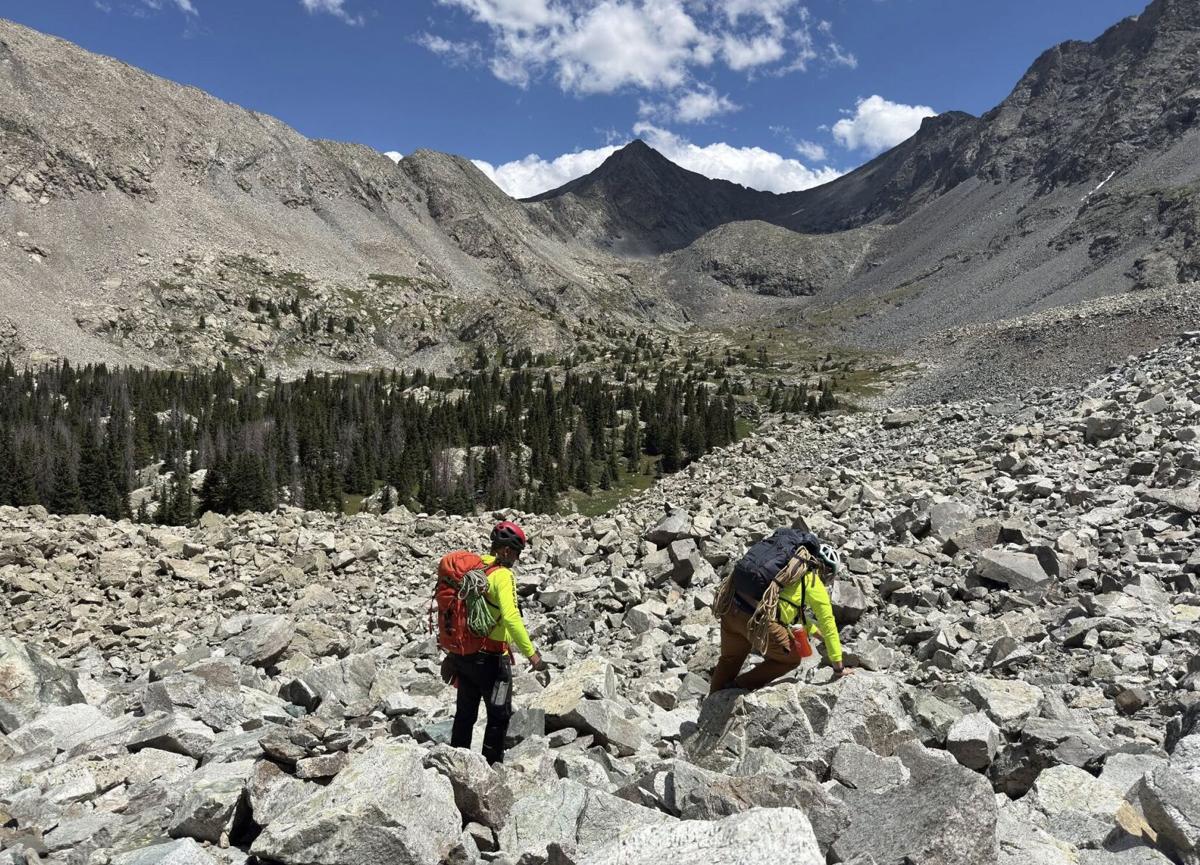Rockfall in ‘Hourglass’ of notoriously dangerous 14er results in severe injuries
$(window).load(function() {
window.setTimeout(affixShare, 2000);
function affixShare() {
var sHeight = $(‘#share-left-affix’).outerHeight(true);
var cHeight = $(‘#share-left-affix’).parent().outerHeight(true);
var sTop = $(‘#share-left-affix’).offset().top – 100;
var sBottom = $(document).height() – ($(‘#share-left-affix’).parent().offset().top + cHeight – 100);
if(cHeight > sHeight) {
$(‘#share-left-affix’).affix({
offset: { top: sTop, bottom: sBottom }
});
}
}
});
$(window).resize(function() {
var sHeight = $(‘#share-left-affix’).outerHeight(true);
var cHeight = $(‘#share-left-affix’).parent().outerHeight(true);
var sTop = $(‘#share-left-affix’).offset().top – 100;
var sBottom = $(document).height() – ($(‘#share-left-affix’).parent().offset().top + $(‘#share-left-affix’).parent().outerHeight(true) – 100);
if(cHeight > sHeight) {
$(‘#share-left-affix’).data(‘bs.affix’).options.offset.top = sTop;
$(‘#share-left-affix’).data(‘bs.affix’).options.offset.bottom = sBottom;
}
});
A terrifying situation unfolded on Colorado’s notorious 14,041-foot Little Bear Peak on Sunday, involving a fall that left a climber unresponsive. Alamosa Volunteer Search and Rescue put out a press release on the matter and a public social media post made by a witness of the accident in the Colorado 14ers Facebook group provides additional detail.
According to bystander Gianna S., the incident took place at about 5:30 a.m. on Sunday morning. Gianna reported that she was climbing the peak with her husband at the time, also having encountered another solo climber traveling along the same route. The three had stopped for a snack near the base of Little Bear’s notorious ‘Hourglass’ feature, which is a steep chute that stretches upward for several hundred feet of exposed and technical terrain, considered to be the crux of the summit-bound route.
While the Hourglass stretch of the route is dangerous in itself, the risk factor is bumped up a notch due to a large area of loose rock that sits above it. This part of the mountain is known for rockfall risk, and a rockfall is exactly what happened.
Without much warning, the hikers heard what Gianna described as “the most loud thunder imaginable from above,” followed by a “microwave to dishwasher-sized boulder” falling down the chute, along with other large rocks. The trio scrambled for cover, and in the chaos, the solo climber reportedly fell about 20 to 30 feet after potentially being struck by one of the rocks. He was not wearing a helmet at the time and was found unconscious and severely injured.
Gianna’s husband called 911, also activating the couple’s satellite-based inReach device. Gianna then noted that her and her husband stayed with the injured climber for several hours, providing aid until search and rescue could arrive.
According to Alamosa Volunteer Search and Rescue, ground and aerial crews were mobilized, with Reach Air Medical inserting three rescuers into Tobin Basin via helicopter while 10 members made the treacherous drive up the rugged Lake Como Road in specialized vehicles. The fallen climber was ultimately hoisted off of the mountain via a Colorado Army National Guard helicopter and transferred to a Front Range hospital for immediate medical care.
“AVSAR extends its gratitude to the reporting parties for their critical assistance in staying on the scene for multiple hours to aid the climber’s needs during this critical time,” reads a statement in the press release from Alamosa Volunteer Search and Rescue.
There are several key takeaways from this situation that can help keep Colorado’s peaks safer.
1. Wear a helmet. Rockfall can pose a major risk on some fourteener routes. Do your research beforehand to determine if that’s the case, and if it is, bring a helmet to wear during dangerous stretches. In general, any route rated as ‘Class 3’ or above will necessitate the use of a helmet, though some exceptions on peaks of a lower grade may apply, too. It’s also important to make sure you’re wearing a helmet designed for rock climbing or mountaineering, as this style of helmet is designed to absorb a blow from a falling rock opposed to helmets used for other activities.
2. Have a means of maintaining communication. In this case, the couple was able to use both a cell phone and a satellite-based communication device to make contact with search and rescue. Having a non-cell phone option for communication is important as something like the Garmin inReach device the couple used can send messages without cellular connectivity. This couple was prepared for getting a message out should a worst case scenario arise and that forethought likely had a major impact on expediting the search and rescue response.
3. Be prepared to wait it out when things go wrong. As was noted by Gianna, even with great communication, the search and rescue response took hours. This can often be the norm given the rugged and dangerous terrain where high elevation rescues of this nature take place. Locations are often remote and weather and other factors can impact an aerial response, plus, these missions are complicated, requiring a lot of coordination between various assets. It’s important to bring along the 10 essentials while exploring Colorado’s backcountry, including layers that can be used to stay warm when an injury is immobilizing. Pack a brightly colored layer, too, as this can be easier for rescue crews to spot opposed to earthy tones.
4. Stagger a group in dangerous terrain. When rockfall is a key risk, spreading a group out a bit while being mindful of each other’s location can be a good safety strategy, similar to how a group might stagger in avalanche-prone terrain or during a lightning storm. Spreading out can help prevent a situation where an entire group is injured at the same time, making it more likely that someone will remain uninjured to provide aid or call for help if needed.
5. Be mindful of where you’re at when taking a break. Before stopping on a mountain, scan an area for potential risks. Sometimes, terrain is too dangerous to really find a truly safe place to stop during a route. If that’s the case and risk will be imminent during a stop, scan the area to come up with a plan for what to do if the situation gets more dangerous – know where you’ll find cover in the event that rocks start falling, for example.
6. Climbing with a partner tends to be safer. While some people prefer to climb solo, it’s generally better to have someone with you on a dangerous route. This makes it possible for someone to call for help if an accident renders someone unconscious or severely injured. That said, climbing with a partner in a rockfall-prone area can come with risk, too, as rocks can be knocked down by one climber onto another. It’s important to be mindful of where other climbers are at and to use proactive positioning that minimizes this risk. As previously noted, a helmet is also key.
If you’re interested in supporting Colorado’s volunteer-powered search and rescue operation, one way to do so is through the purchase of a CORSAR card. It’s cheap, at only $5 per year.
STAY INFORMED: Get free Colorado news with our daily newsletter (Click here)




